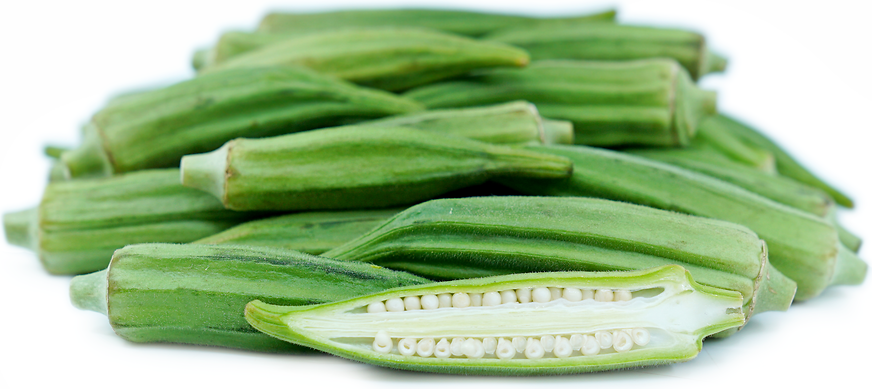


Green Okra
Estimated Inventory, 22 lbs : 0
Description/Taste
Green okra is a torpedo-shaped pod fruit that ranges in length from about 7.5 to 15 centimeters long. Each slender pod has a lime green hue and an exterior with furrowed lengthwise grooves. Its skin has a soft and slightly fuzzy texture due to the tiny white hairs that cover its surface. When cut in half, Green okra reveals a pale green-white flesh that’s split up by a thin fibrous wall. On either side of this wall are numerous round white seeds encased in a translucent, sticky gel that may give the fruit a slightly slimy texture. Green okra has a mild, grassy flavor reminiscent of eggplants and green beans.
Seasons/Availability
Green okra is available year-round with a peak season from late spring to early fall.
Current Facts
The botanical name for Green okra is Abelmoschus esculentus and it is a member of the mallow family along with cotton, cocoa, and hibiscus. The word okra derives from okuru in the Nigerian Igbo language and ki ngombo in many Bantu languages, which also inspired the name of the popular gumbo soup in which it is commonly used. Okra is technically a fruit despite being treated as a vegetable in culinary preparations. Its plant serves both culinary and ornamental purposes, producing broad oak-shaped leaves with bold yellow and white hibiscus-like blossoms. Green okra prefers to be planted alongside companion plants like basil, cucumbers, eggplant, melons, peppers, and southern peas. It is grown commercially for pickling and canning while its seeds may be harvested to make oil.
Nutritional Value
Green okra is a source of vitamins K and C, nutrients vital for blood clotting, antioxidant protection, immune support, collagen production, iron absorption, and heart and bone health. The folate and manganese found in this fruit can help with cell growth, wound healing, mood regulation, cognitive function, oxygen transportation, metabolism, and bone density. Green okra contains fiber and a protein called lectin that assists with digestion, blood sugar control, gut health, and reducing damage from free radicals. Leaves from the Green okra plant are used in Turkey to soothe and reduce inflammation. In Western Ethiopia, pregnant women use Green okra because its folate content supports neural tube development in a baby's brain and spinal cord, potentially preventing birth defects like spina bifida.
Applications
Green okra can be eaten raw but is more often cooked, roasted, grilled, or deep-fried. In the American South, it's often battered whole, fried with a cornmeal coating, or incorporated into soups like gumbo. Green okra is used in Brazilian recipes such as caruru, a Middle Eastern dish called bamya, an Indian dish known as kurkuri bhindi, and a West African stew called okro, which is made with meat, fish, and spinach. This fruit can be pickled and incorporated into a savory cocktail like Blood Marys or dehydrated for a crunchy snack. Green okra pairs well with bacon, ham, butter, cream, mozzarella, garlic, onions, olive oil, basil, parsley, lemon, lime, kale, beets, salad greens, turnips, tomatoes, pickled vegetables, chile peppers, peppercorns, paprika, allspice, coriander, and jalapeños. To avoid sliminess, it can be dipped in vinegar or lemon juice before cooking. Green okra should be bagged and stored unwashed in the fridge where it can last 2 to 3 days.
Ethnic/Cultural Info
Green okra seeds were used as a coffee substitute during the Civil War. The Union blockade of the South made it difficult for Confederate states to obtain goods like coffee. This scarcity led Southerners to find creative substitutes for this beverage. They first experimented with persimmon seeds and chicory before landing on Green okra. Its seeds had a spicy aroma with fruity and earthy undertones that mimicked the flavor, scent, and ritual of coffee drinking. The only difference was that Okra lacked the caffeine of coffee, making it more similar to decaffeinated versions of the drink. Green okra coffee was also drunk in Central America, Africa, and Malaysia.
Geography/History
Green okra is native to the Abyssinian center of origin of cultivated plants, which includes present-day Ethiopia, the mountainous regions of Eritrea, and the northern part of Sudan. During the 12th century, this fruit was transported on the Red Sea from Arabia to Egypt. It was then adapted throughout the Mediterranean and eastward in Asia. Green okra eventually reached the New World through the triangular trade route, arriving in Brazil from Africa in the 17th century and later brought to Louisiana by French colonists in the 18th century. Green okra is a warm-season crop that flourishes in tropical and temperate climates. It requires full sun and can tolerate limited rain and irrigation. Green okra grows wild along the Upper Nile, especially in Ethiopia and the White Nile region. It can also be found growing commercially and in home gardens in the United States, India, Saudi Arabia, Cameroon, Nigeria, Mali, Pakistan, Mexico, and Southeast Asia. Green okra is most popular in the American South, where the majority of its commercial production occurs in Texas, Florida, and Georgia.
Recipe Ideas
Recipes that include Green Okra. One

















